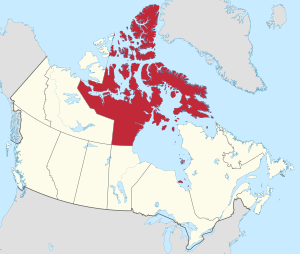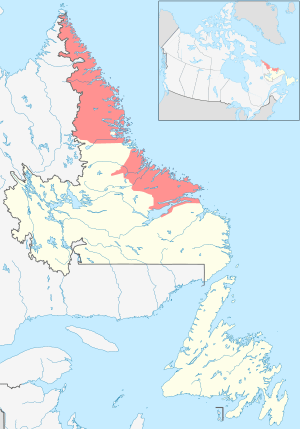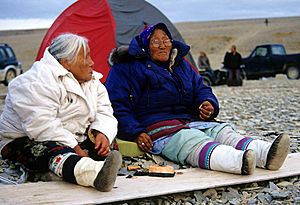Inuit Nunangat facts for kids
Quick facts for kids
Inuit Nunangat
ᐃᓄᐃᑦ ᓄᓇᖓᑦ
|
|
|---|---|
|
Inuit Regions of Canada
|
|
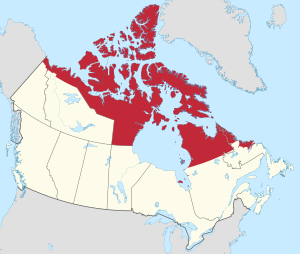 |
|
| State | Canada |
| Regions | Inuvialuit Nunangat, Nunavut, Nunavik, Nunatsiavut |
| Province/Territory | NT, YT, NU, QC, NL |
| Area | |
| • Total | 3,304,740 km2 (1,275,970 sq mi) |
| • Land | 2,484,591 km2 (959,306 sq mi) |
| • Water | 820,149 km2 (316,661 sq mi) |
| Population
(2016)
|
|
| • Total | 56,585 |
| • Density | 0.01712238/km2 (0.0443467/sq mi) |
| • Inuit | 47,335 |
| Time zone | UTC−08:00 (PST) UTC−07:00 (MST) UTC−06:00 (CST) UTC−05:00 (EST) UTC−04:00 (AST) |
| • Summer (DST) | Varies |
| Inuit languages (West to East) | Inuvialuktun Inuktut (Inuinnaqtun, Inuktitut) Atgangmuurngniq Inuttut |
Inuit Nunangat (pronounced "IN-yoo-it NOO-nah-ngat") is the special homeland of the Inuit people in Canada. The name means "lands, waters, and ices of the Inuit people." It is a huge area in the Arctic part of Canada.
This homeland includes four main regions:
- The Inuvialuit Settlement Region in the Northwest Territories and Yukon.
- The territory of Nunavut.
- Nunavik in northern Quebec.
- Nunatsiavut in Newfoundland and Labrador.
Contents
What Does "Inuit Nunangat" Mean?
The word "Nunangat" is from the Inuktitut language. It was chosen in 2009 by Canadian Inuit. This word shows how important the land, water, and ice are to their culture. Before 2009, a different word, "Nunaat," was used. But "Nunaat" did not include the waters and ice.
A Look at Inuit History
Early Inuit Settlements
The ancestors of the Inuit, called the Thule, arrived in the Arctic. They replaced an older group known as the Dorset culture (or Tuniit). The Thule people came from Siberia about 4,000 years ago. They brought new tools and transport dogs. By 1300 CE, they had reached western Greenland.
Inuit traded with nearby groups like the Gwich'in and Chipewyan. They also traded with the Innu. Sometimes, there were conflicts. Europeans, like the Norse and Basques, also traded with some Inuit groups.
A sad event happened in 1576. An explorer named Martin Frobisher kidnapped three Inuit people from Baffin Island. They were taken to Europe and later died there.
Changes During Canadian Colonization
Over time, Canadian rule spread into Inuit Nunangat. This brought many changes. Diseases spread, and new ways of life were introduced. Christian churches and Canadian police also became part of the communities. These changes caused difficulties for Inuit Nunangat.
Unlike some southern First Nations, Inuit Nunangat was not widely settled by Europeans. However, Inuit faced policies that tried to make them change their ways. For example, many sled dogs were lost between 1950 and 1970. Some Inuit families were also moved far north in the High Arctic relocation. Many Inuit children were forced to attend residential schools. These experiences caused language loss and lasting challenges for Inuit families.
Inuit Nunangat Today
Today, Inuit Tapiriit Kanatami (ITK) helps lead Inuit affairs in Canada. ITK means "Inuit are united with Canada." It acts as a central group for Inuit culture and governance.
Each region of Inuit Nunangat has its own agreements with Canada:
- Nunavut became a territory in 1999. This was a big step for Inuit self-governance.
- The Inuvialuit Settlement Region gained its own corporation in 1986.
- Nunatsiavut in Labrador got its own government in 2005.
- In Nunavik, the Makivik Corporation was created in 1978.
There is also NunatuKavut, which is not formally part of Inuit Nunangat. They have a treaty with the British from 1765 that is still in effect.
In 2017, the Inuit-Crown Partnership Committee (ICPC) was formed. This group works together to support Inuit Nunangat. In 2022, they approved the Inuit Nunangat Policy. This policy officially recognizes the Inuit homeland as a special cultural and political region. It includes the land, sea, and ice.
Who Lives in Inuit Nunangat?
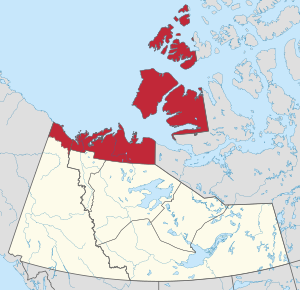
In 2016, about 56,585 people lived in Inuit Nunangat. Most of these people, about 47,335, are Inuit. This means that over 83% of the people living there are Inuit.
| Region | Total | Inuit | First Nations | Métis | Other Indigenous | Non-Indigenous |
|---|---|---|---|---|---|---|
| Inuvialuit Settlement Region | 5,330 | 3,110 | 860 | 130 | 25 | 1,205 |
| Nunavut | 35,575 | 30,135 | 190 | 165 | 60 | 5,025 |
| Nunavik | 13,125 | 11,800 | 135 | 30 | 30 | 1,130 |
| Nunatsiavut | 2,555 | 2,290 | 25 | 35 | 0 | 205 |
| Totals | 56,585 | 47,335 | 1,210 | 360 | 115 | 7,565 |
Most Inuit in Canada (about 72%) live in Inuit Nunangat. The rest live in other parts of Canada.
Major Communities in Inuit Nunangat
Here are some of the largest communities:
| Municipality | Region | Population |
|---|---|---|
| Iqaluit | Nunavut | 7,082 |
| Inuvik | Inuvialuit Settlement Region | 3,243 |
| Kuujjuaq | Nunavik | 2,754 |
| Rankin Inlet | Nunavut | 2,441 |
| Arviat | Nunavut | 2,318 |
| Baker Lake | Nunavut | 1,872 |
| Puvirnituq | Nunavik | 1,779 |
| Inukjuak | Nunavik | 1,757 |
| Cambridge Bay | Nunavut | 1,619 |
| Pond Inlet | Nunavut | 1,549 |
- Iqaluit is the capital city of Nunavut.
- Inuvik is a main center for the Inuvialuit Settlement Region.
- Kuujjuaq is the main community for Nunavik.
- For Nunatsiavut, Hopedale is the legislative capital. Nain is the administrative capital.
Languages Spoken
Many different languages are spoken across Inuit Nunangat. These languages are related and form a "dialect continuum." This means that people speaking neighboring dialects can usually understand each other.
The main oral languages in Canada are:
- Inuvialuktun in the west.
- Inuktitut, which is the most widely spoken.
- Inuinnaqtun, which is between Inuktitut and Inuvialuktun.
- Inuttitut in Labrador.
There is also Inuit Sign Language (Atgangmuurngniq). It is used in some Nunavut communities. It is passed down through generations, even if people are not deaf.
Inuit Peoples
The Inuit are a diverse group of people. They share many cultural and language similarities. They use both spoken languages (like Inuktut) and sign languages.
- Peoples of Inuit Nunangat:
- Nunavummiut
- Kivallirmiut
- Nunavimmiut
- Inuvialuit
- Nunatsiavummiut / Labradorimiut
- Inuit outside Nunangat:
- NunatuKavummuit
- Kalaallit (Greenland)
- Inughuit (Greenland)
- Tunumiit (Greenland)
- Iñupiaq (Alaska)
Geography and Climate
Inuit Nunangat covers a large part of the North American Arctic. Most of this area is above the tree line. This means it is too cold for trees to grow.
Climate Change in Inuit Nunangat
Climate change is a big concern in the Arctic. The Inuit Tapiriit Kanatami created a plan in 2019. It is called the National Inuit Climate Change Strategy. This plan helps Inuit respond to the effects of climate change on their lands and way of life.
Inuit Culture and Traditions
Inuit culture has a long history. It includes many types of music, sports, and other traditions.
Music and Art
Inuit Nunangat is home to many talented musicians and bands. Some well-known artists include Joshua Haulli, Quantum Tangle, The Jerry Cans, Elisapie, and Tanya Tagaq. The Alianait Music and Arts Festival is a yearly event that showcases artists from Inuit Nunangat and around the world.
Inuit are also famous for their art, especially carvings made from soapstone. While power tools are sometimes used, many artists prefer to carve with an axe and file.
Traditional Tools and Transport
The modern kayak comes from the Inuit qajaq. Inuit also use a larger boat called an umiaq. It is a wood-framed, flat-bottomed boat used to carry people, goods, and dogs.
On land, qamutiks were pulled by huskies (or qimmiit). However, many sled dogs were lost between the 1950s and 1970s. Since then, Inuit have started using motorized vehicles like the Ski-Doo for travel.
Inuit Cuisine (Country Food)
Inuit cuisine is often called "country food." It uses many local meats and plants.
- Meats: Walrus, narwhal, bearded seal, caribou, polar bear, Arctic cod, and Arctic char.
- Plants: Crowberries, cloudberries, fireweed, seaweed, and various roots.
Much of the meat is eaten frozen, raw, or boiled. This is similar to sushi or sashimi.
Some special Inuit foods include:
- Akutuq: An ice cream-like dessert made with fat, meat, and berries.
- Igunaq: Meat that has been fermented for a year.
- Maktaaq: Frozen whale skin and blubber. It is usually eaten raw, but sometimes pickled or fried.
- Labrador tea: A traditional drink.
- Dips: Such as aalu (made from caribou or seal parts), misiraq (aged seal or whale blubber), and nirukkaq (a smooth paste from a caribou's stomach).
Laws and Traditions
Inuit Nunangat follows different legal systems. Like all of Canada, it uses the federal Criminal Code for criminal laws.
The regions in the Northwest Territories, Yukon, and Nunavut follow English common law. Nunavik, in Quebec, follows the civil law tradition for private matters.
Inuit also follow their own traditions called Inuit Qaujimajatuqangit (IQ). This means "that which has long been known by Inuit." IQ traditions focus on how everything is connected. Inuit leaders believe that everyone helps the community work well.
The Nunavut Court of Justice is a special court in Canada. It travels to communities to hear cases. There are also programs that use traditional healing circles. These programs help combine Inuit traditions with the Canadian legal system.
See also
 In Spanish: Inuit Nunangat para niños
In Spanish: Inuit Nunangat para niños



